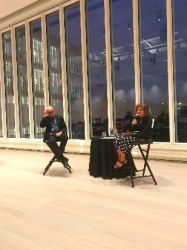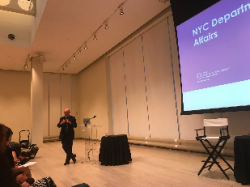On Thursday evening, the Lenfest Center for the Arts at Columbia’s Manhattanville campus hosted their inaugural event for the 2017-2018 season in the Lenfest’s 8th floor “Lantern”. The event featured a presentation by Tom Finkelpearl, Commissioner for New York City’s Department of Cultural Affairs. Bwog sent Events Editor Lexie Lehmann to check it out.
As Bwog’s resident Urban Studies major, I felt it was my duty to trek up to Manhattanville to see Commissioner Tom Finkelpearl discuss his newly released CreateNYC report, a cultural plan for New York City residents aimed at increasing the accessibility and equitability of cultural events and organizations in the city. More than a report, it’s a blueprint: according to the Plan’s description, CreateNYC aims to “serve as a roadmap to a more inclusive, equitable, and resilient cultural ecosystem, in which all residents have a stake.” In other words, it’s an URBS dream-come-true.
Finkelpearl’s presentation was preceded by a short speech by Carol Becker, Dean of Columbia’s School of the Arts, and Ester Fuchs (my main #girlboss), Director of Urban and Social Policy at Columbia’s School of International and Public Affairs. In her introduction, Fuchs explained that she and Finkelpearl shared a similar background, having both started their careers in boroughs of the city besides Manhattan. Fuchs was born in Queens, where Finkelpearl served tenure as the director of the Queens Museum.
Fuchs was also sure to emphasize the small size of the Department of Cultural Affairs as compared to its wide scale of implementation in the city. Despite possessing one of the smallest department budgets, the DCA manages 33 main agencies and several hundred other cultural and artistic properties around the city. That said, size is relative — Finkelpearl was quick to follow up in his own presentation about the budget of the Department still consisting of a whopping 320 million dollars annually.
Finkelpearl’s presentation of CreateNYC was very compelling; he begun first by expressing the problem of a lack of ethnic and racial representation among the staff and executive boards of many of New York’s cultural organizations. He referenced a study, conducted in tandem with the University of Pennsylvania, that acknowledged the social benefits of community engagement with the arts. Aside from increased economic productivity and a rise in tourism, the study found that areas with a higher concentration of arts centers are healthier, have higher rates of educational retention, as well as increased personal security.
CreateNYC establishes 94 recommendations for the city of New York to promote equitable access to the arts. Among many, Finkelpearl listed the most important recommendations as those concerned with increasing disability access to museums, increasing the diversity of staffing in cultural centers, decreasing the price of cultural events for low-income citizens, and improving preexisting arts centers’ environmental footprint(s).
Dean Carol Baker posed an interesting question to Finkelpearl during the question and answer period: why government? She added that the Trump administration has not been too kind to the arts, as demonstrated by the recent disbandment of the President’s Commission on the Arts, and Tom’s CV could easily get him tenure at just about any academic institution in the country. Tom answered with an anecdote about government response to natural disasters; following a hurricane, there are certain actions of large scale that can only be executed by a government power. In the case of increasing equitable access to the arts, in order to do so at the scale of an entire metropolitan city, the public sector is – albeit surprisingly – the most successful route.
Finkelpearl closed with a comment about the value of being “subversive within traditional structures.” As with being an artist, creating change – particularly revolutionary change – often requires going beyond the status quo and challenging authority figures that may obstruct process. This is something that both art, as well as social justice, have in common.
You can read more about CultureNYC here.
I also encourage you to check out the other great events that Columbia’s School for the Arts has planned for this year. I am particularly jazzed about the opportunity to hear from social justice artist and personality, Ai Weiwei, this coming October. You can find the School of the Arts’ program schedule here.
Can we talk about how pretty the Lenfest Lantern is…
- Amazing
- Look at those hardwood floors


 1 Comments
1 Comments



1 Comment
@Anonymous What money and support is DeBlasio and New York City going to give Columbia to maintain Lenfests commitment to the neighborhood, or is Columbia footing the entire bill?